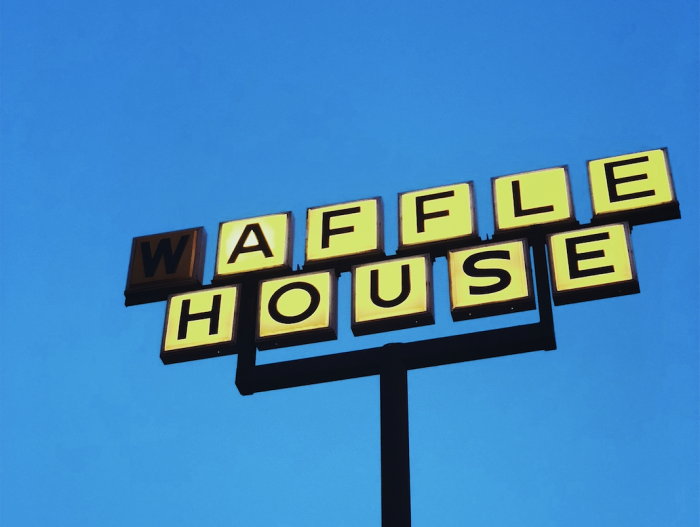Disaster Preparedness: The Waffle House Way
In 2014, one of our former staff members had the opportunity to sit down with an executive at Waffle House. Since Hurricanes Florence and Michael have revived the discussion about the restaurant as a bellwether of the severity of a storm and of Southern communities’ recovery, it seemed fitting to revisit the conversation and the lessons […]


In 2014, one of our former staff members had the opportunity to sit down with an executive at Waffle House. Since Hurricanes Florence and Michael have revived the discussion about the restaurant as a bellwether of the severity of a storm and of Southern communities’ recovery, it seemed fitting to revisit the conversation and the lessons learned in disaster preparedness.
In the aftermath of a disaster, an important measurement to the full recovery of an area is the operating status of businesses in the affected areas. Some national disaster management leaders have used the status of Waffle House restaurants after a disaster to gauge well-being of an area – meaning that if a restaurant was not operating, most likely there were no functioning utilities, available employees or open roads — or some combination of those factors — which in turn meant an area was still severely affected post-disaster. The Waffle House chain is seen as a leader in the business world for being disaster ready, planning ahead for disasters and staffing a mobile command center. In 2014, Anna Hurt had a chance to ask Pat Warner, vice president of culture at Waffle House, about why being prepared is so important, and what being disaster ready brings to a business and its employees.
CDP: Late last year, there was some media coverage of W. Craig Fugate’s (FEMA) use of Waffle House as a disaster severity indicator. What is it in the Waffle House company culture that caused you to place such importance on being prepared for a natural disaster?
Pat Warner: It started really when we first were founded. In 1955, Joe Rogers, Sr., and Tom Forkner opened the first Waffle House and from day one, we’ve been open 24/7. Joe has said that if you want to be a service to your community, then you need to be there for them 24/7. That has carried over through today. A great example is right after the Moore, Oklahoma, tornadoes a few years back, the authorities had closed down some roads preventing our folks from getting to the restaurant. A car load of our associates told the local deputies they HAD to get to their restaurant for their customers. The deputies let them through. Our associates build bonds with their customers, so after a disaster, we want to be there for our customers. And the second reason is, as a company, we owe it to our associates to open up quickly, so they can go back to earning money. They have just come through a life-changing event and need to get back to normal. And we think that opening quickly helps our associates earn much-needed money and gets them back to a sense of normalcy.
CDP: Some of the Waffle House preparedness mechanisms include portable generators, a mobile command center and employee training. What else have you developed as a company standard to be prepared for a disaster and was there a specific disaster that created the development of these things?
Warner: After each disaster, we do an after-action report where we look for lessons learned. We are always working to improve. After Hurricane Hugo in 1989, we learned that we needed a more systematic way of closing and re-opening restaurants. And from that came a hurricane playbook that we update each year with the latest protocols for taking care of our associates and for better ways of responding. After Hurricane Katrina in 2005, we learned that we need to have similar systems on taking care of our associates and families.
CDP: And as a follow-up to the previous question, what disaster had the largest effect on your company and how long did it take to completely recover?
Warner: Like above, the two biggest were Hugo, which taught us to systemize our response and Katrina, which was the biggest disaster we had to respond to. In Katrina, we had to shut 107 restaurants down along the I-10 corridor from Florida over to Louisiana. That was by far the biggest response effort we have had to launch.
CDP: What are the lessons learned from being disaster ready as a company that you would convey to other businesses?
Warner: The biggest two are have an action plan and communicate it to your employees. Companies need to do “what if” scenarios on major threats to their business and come up with a plan to react. Then communicate that plan to your employees. Now remember that the plan just gets you there. You then have to show up right after the crisis and, using the plan, react to the realities the crisis presents.
CDP: What do businesses gain from being prepared for disasters?
Warner: There are many gains from being prepared. First, you must take care of your employees. They are depending on the company for their livelihood and after a crisis; companies need to be doing all they can, so their employees can get back to work. Second, the customers that relied on you before the crisis will really need you there after the crisis. These are the two groups we focus on in our preparedness – our associates and customers. It’s costly to show up right after a storm, and that’s why most businesses don’t do it. However, we believe we can’t afford not to.
More like this

The Time to Prepare is Now
